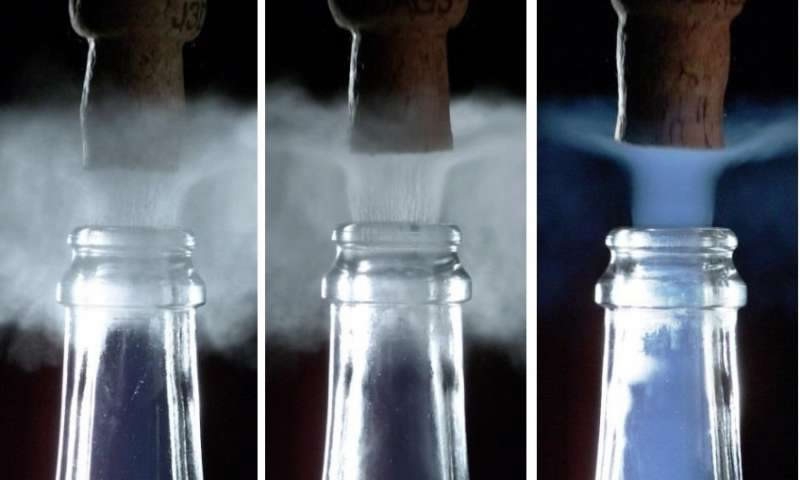
Tech & Sci
10:24, 15-Sep-2017
Champagne releases 'blue gas' if not quite chilled
CGTN

Champagne has a blue gas if it had been stored at 20 degrees Celsius, a sign it may not be quite as chilled as expected, according to research published in the journal Scientific Reports Thursday.
Using a super-high-speed camera, "we observed a bluish cloud that was totally unexpected" when researchers opened bottles at 20 degrees Celsius, said study co-author Gerard Liger-Belair, a professor at the University of Reims in France's Champagne region, where he studies bubbles and foam.
Bottles chilled to six or 12 degrees Celsius–release a grey-white fog when opened, a better-known phenomenon that occurs when gas gushing from the bottleneck expands as it escapes from the higher pressure inside.

Three snapshots, taken 1.2 ms after the cork popping process, showing the condensation of water vapor above the bottlenecks of bottles stored at 6 °C, 12 °C, and the deep blue CO2 freezing plume gushing from the bottleneck of the bottle stored at 20 °C, respectively. /URCA Photo
Three snapshots, taken 1.2 ms after the cork popping process, showing the condensation of water vapor above the bottlenecks of bottles stored at 6 °C, 12 °C, and the deep blue CO2 freezing plume gushing from the bottleneck of the bottle stored at 20 °C, respectively. /URCA Photo
When this–a process known as adiabatic expansion -- happens, the temperature of the gas plummets and condensates to form the whitish fog familiar to those who enjoy clinking the occasional flute.
The recommended drinking temperature for bubbly is eight to ten degrees Celsius.
At 20 C, the study authors found, something strange happens. There is no white cloud, but rather a fleeting blue plume which starts inside the bottleneck.
The team used cameras that can take up to 12,000 pictures per second to observe the first thousandths of seconds after a cork is removed.
"Bottles at 20 degrees Celsius were under such a pressure (in the order of eight bar) that the adiabatic expansion allowed the temperature of the escaping gas to plummet to a glacial temperature of minus 90 degrees Celsius," said Liger-Belair.

Time sequences show the cork popping process from bottles stored at three different temperatures. /Discover Magazine Photo
Time sequences show the cork popping process from bottles stored at three different temperatures. /Discover Magazine Photo
Like the sky
This is colder than the freezing point for carbon dioxide. The ambient pressure at sea level is about one bar.
"The bluish cloud forms when the CO2 transforms into miniature particles of dry ice which reflect the ambient light," explained the researcher. "This blue cloud has the same physical origin as the blue colour of the sky. Is that not extraordinary?"
The blue fog is not visible to the naked eye as it lasts only about two or three thousandths of a second.
The sky is blue because tiny molecules in the air scatter blue light, which has a shorter wavelength and higher frequency, more strongly than other colors.
Source(s): AFP

SITEMAP
Copyright © 2018 CGTN. Beijing ICP prepared NO.16065310-3
Copyright © 2018 CGTN. Beijing ICP prepared NO.16065310-3